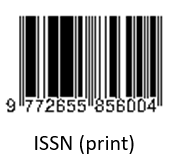The Effect of the Number of Cooling Pads on the Output Air Condition and Effectiveness of Air Cooler
(1) Sanata Dharma University Yogyakarta
(*) Corresponding Author
Abstract
To get comfortable air, it can be done by using an air conditioner or air cooler. The electrical power used for the air cooler is relatively lower. This research aims to see the effect of the number of cooling pads on the output air condition and on the effectiveness of the air cooler. The research was conducted experimentally. The research was conducted by varying the number of cooling pads used,
thick. The distance between the cooling pads is 1.5 cm. The air temperature inlet of the air cooler has a dry bulb air temperature of 30oC with an air humidity (RH) of 60%. The lowest dry bulb air temperature achieved was 24.04 oC when the number of cooling pads was 6 pieces. The highest air cooler effectiveness achieved was 0.99. Research has given satisfactory results. However, research can be developed by varying the cooling pad material or cooling pad pattern in order to obtain a small number of cooling pads
Keywords: Air cooler, Effectiveness, Cooling pad
Full Text:
PDFReferences
W. Arismunandar, S. Heizo, “Penyegaran Udara Edisi ke 4”, Pradnya Paramita. Jakarta. 1991.
J. K. Jain, D.A. Hindoliya, “Experimental performance of new evaporative cooling pad material”, Mechanical Engineering Department, Ujjain Polytechnic College, Ujjain (M.P.) 456010, India, 2011.
Charles W. Albrecht, Evanston, Wyo, “Evaporative Air Cooler”, United State Patent, Patent Number 4,953,831, Date of Patent: Sep. 4, 1990.
James A. Brock, Alexander, Ark, “Portable Evaporative Air Cooler”, United State Patent, Patent Number Des. 337,817, Date of Patent: Jul. 27, 1993
Peter Sydney Wright, Blackwood, Australia, “Off-Road Evaporative Air Cooler”, United State Patent, Patent Number, Des. 433,111, Date of Patent: Oct. 31, 2000
William R. Calton, Scofield Dr., Cupertino, “Evaporative Cooling”, United State Patent, Patent Number 5,715,698, Date of Patent: Feb. 10, 1998.
United State Patent, Patent Number 5,168,722, Date of Patent: Dec. 8, 1992
James A. Brock, Alexander, Ark, “Portable Evaporative Air Cooler”, United State Patent, Patent Number Des. 337,817, Date of Patent: Jul. 27, 1993.A
R.S. Khurmi, J.K. Gupta, “A Text Book of Refrigeration and Air Conditioning”, Eurasia Publishing House (P) Ltd, Ram Nagar, New Delhi-110055. 1995.
Doddy Purwadianto, Petrus Kanisius Purwadi, “Hubungan Kondisi Udara Masuk dengan Kondisi Udara Keluaran Air Cooler”, Jurnal Ilmiah Widya Teknik, 20(2), 2021.
I Nyoman Suryana, I Nengah Suarnadwipa, Hendra Wijaksana, “Studi Eksperimental Performansi Pendingin Evaporative Portable dengan Pad Berbahan Spon Dengan Ketebalan Berbeda”, Jurnal Ilmiah Teknik Desain Mekanika, 1(1), September 2014.
Ekadewi A. Handoyo, Fandi Dwiputra Suprianto, Selrianus, “Penggunaan Serabut Kelapa Sebagai Bantalan pada Evaporative Cooler”, Seminar Nasional Teknik Mesin 3, 30 April 2008, Surabaya, Indonesia, 2008.
Toni Dwi Putra, Nurida Finahari, “Pengaruh Perubahan Temperatur Media Pendingin pada Direct Evaporative Cooler”, Proton: Jurnal Ilmu – Ilmu Teknik Mesin, 3(1), 2011.
Hendra Listiono, Azridjal Aziz, Rahmat Iman Mainil, “Analisis Evaporative Air Cooler dengan Temperatur Media Pendingin yang Berbeda”, Jurnal Online Mahasiswa Fakultas Teknik. 2(2). 2015.
M.D. Amri, B. Yunianto, “Pengaruh Debit Aliran Air terhadap Efektifitas Direct Evaporative Cooling dilengkapi Cooling Pad Serabut Kelapa”, Jurnal Teknik Mesin S-1, 2(2), 2014.
DOI: https://doi.org/10.24071/ijasst.v4i2.5313
Refbacks
- There are currently no refbacks.
Publisher : Faculty of Science and Technology
Society/Institution : Sanata Dharma University

This work is licensed under a Creative Commons Attribution 4.0 International License.











